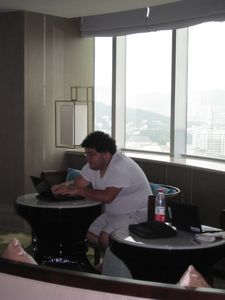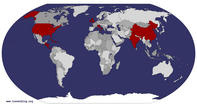Advertisement

 06301004HTristanexam
06301004HTristanexam
Tristen taking his Microbiology examThursday 6/30: Lots of green scenes!
West Lake, Tea Plantation, Buddhist Monastery
Today toured Hangzhou's exceptional West Lake (Xi Hu), which is about 3 miles across and 9 miles around. The area around the lake is filled with islets and temples, pavilions and gardens, causeways and arched bridges, which have constituted the supreme example of lakeside beauty in China ever since Hangzhou served as China's capital during the Southern Song Dynasty. We began with a ½ hour walk through the beautiful gardens towards the boat dock. During the tour, we saw: Solitary Island (Gushan Dao), situated on the lake's northwest shore, connected to the mainland by the Xiling Bridge, dedicated to poet Su Xiaoxiao (picture of her tomb later), who was entombed here in AD 501; and the Bai Causeway (Bai Ti), which connects Solitary Island to downtown and is named after a Tang Dynasty poet, Bai Juyi, who served as prefectural governor here in A.D. 822 to 824. Our tour also included Three Pools Mirroring the Moon, which is located just off the southern shore of the Island of Little Oceans. This monument consists of three little water pagodas, each about 6 ft. tall, which have floated like
buoys on the surface of West Lake since 1621. We saw the Su Causeway (Su Ti), a great dike that connects the north and south shores along the western side of West Lake, featuring weeping willows, peach trees, and shady nooks, six arched stone bridges and beautiful vistas of the lake. Very romantic—the willows bring to mind the girls hair and the peach blossoms their faces. The causeways are only for bikes, scooters, pedestrians. There are 18 white swans on the lake and the citizenry keeps track of them and where they are. Lots of tea houses around the lake. There’s a sluice gate for the lake which lets water into the Grand Canal. The South never lacks for water; 2/3 of China’s cities don’t have enough water, are on rationing. They have a water bus in town, from the Channel river to the lake to the grand canal but it’s not used much.
Chinese brides getting formal wedding pictures taken “need” to have a picture with each of the four seasons’ flowers: bamboo, plum, lotus, and chrysanthemum. Not sure how to do all of that when it’s summer and the plums are done and mums won’t bloom till

 06301005Exam&Proctor
06301005Exam&Proctor
Susan as the proctor for his examfall but we saw a bunch of them getting their pictures taken near one of the lotus gardens. At first, I thought they were model taking pictures for ads or something like that but our guide filled us in.
From the guide: The dragon has 9 sons who are in charge of his kingdoms. Chaing Kai-Shek had 3 villas in Hangzhou: 1 for himself, 1 for his wife, 1 for his son. Lots of western style villas along the lake. People over 70 ride the bus for free: they ride to the park with their tea, a little lunch, and a book, spend the day, then ride back home. It’s a natural lake, a lagoon (silt-filled) lake. To “go to the West” is to die. The zig zag bridge is that way to confuse the demons. Buddha is one god, Tao has lots of gods. Read the book, The Dark Side of Innocence”. West Lake is to the West of the city (!). Lots of history: Province (Zhejiang) for 5000 years, City 2000 years.
In 1912, Sun Yat Sen was elected President. The white house with the entry way is his villa. He died in 1925 and was
buried in Nanjing. It had been an emperor’s palace before hand.
Lotus leaves, harvested in the fall, are good for salad, seeds are dried for insomnia. The plants in the gardens stay in the plastic pots and are changed out monthly.
Taxi drivers have plexiglass shields behind them, between the front and back seats (several garroting incidents a few years ago) and also to their right, in case there’s a rider in the front seat. Something we’ve done a couple of times in different places: turn left from the right lane, in front of other traffic going our same way – really strange but it was part of the flow.
The Emperor’s seal is the only one that can be in the middle of a canvas. The stele, written by the 4th Ch’ing emperor invites us in and to enjoy the lotus garden. We also saw the gateway for the national hero (died in the Mongol invasion). The big trees with the patchy bark are sycamores.
60 million tourists annually, mostly Chinese. 2,000 workers: 500 staff, 1500 summer temporary.
The Chinese government encourages the use of Chinese traditional medicine. While Western medicine concentrates on curing
disease, Chinese looks at the whole body and preventing problems.
When Nixon came in 1972, he brought California Redwood to plant. They’ve harvested 500 seedlings already and they’re part of the 2900 plants in the botanical gardens (hot and cold plants). When Nixon came to town, there was a convoy from the airport. All citizens were ordered to stay home for three days and the army boys and girls dressed up as regular citizens.
Then we went to the Dragon Well Tea Plantation (Cha Yuan Chun), featuring extensive displays of Chinese teas, pots, cups, and ceremonial tea implements. Our visit also included a Tea Sampling and Demonstration of the Chinese Tea Ceremony in a private tearoom. Dragon Well is green tea and I wouldn’t call it so much a tea ceremony as tasting and selling! Surprise! The plantation itself was fascinating to see and learn about and lovely to boot! We learned lots about anti-oxidants, different months to pick tea, to brew it, what the difference between green, red, oolong, and black tea are (fermentation levels). Basically, any kind of tea can be made from any bush, just depends on when you pick it and how you handle
it. Tea is named by the place (Dragon Well, Darjeeling) or the process (oolong, green). Fresh tea smells like grass; fermenting gets rid of the smell. Green is not fermented, red is fermented only a couple of days, oolong is ½ fermented, black is fully fermented. Choose good tea by 1) look at the leaves, hint of yellow means ‘new’; 2) light smell, makes you feel good; 3) taste—have 3 glasses and then return in ½ hour and see how you feel. This is obviously how to pick a tea for purchase and future use, not just for one cup! During the Cultural Revolution, tea was grown for export; now, farmers can decide what kind to grow and sell or keep it themselves. Use no insecticides. No tea is planted on mountain top or river bank, too cold and wet.
We concluded the day with a visit to Lingyin Temple (Temple of the Soul's Retreat), which has been rebuilt a dozen times since its creation in AD 326. Our guide took us a little off the ‘main’ path so we’d not be around so many of the crowds—the grounds are beautiful! The top attraction on the way to the
temple was a limestone cliff, called the Peak That Flew from Afar (Feilai Feng), so named due to its resemblance to a holy mountain in India seemingly transported to China. The peak contains four caves and about 380 Buddhist rock carvings, most of them created over 600 years ago during the Yuan Dynasty. The most famous carving here is of a Laughing Buddha (he really did look happy), carved in the year AD 1000. The small pagoda at the entrance to the first temple is the burial marker for a monk named Huili, who founded Lingyin Temple 16 centuries ago. The present buildings are immense, some of the grandest temples in China. These were fascinating, especially when you consider that they were carved in the dark (except for candlelight). Many of the faces of the semi-gods had been smashed off by the members of the Red Guard during the Cultural Revolution, very sad. Got to wade across a creek of ice cold water—felt so good! Glad I wore my Tevas, not tennis shoes (there were rocks for those folks).
Pardon my spelling: Amitaba is the Buddha of the West; Sykamony is Buddha himself. The Goddess of Mercy is the
only feminine Buddha and she is uniquely Chinese. If a statue of Buddha has is hand fingers pointing up, have no fear. If his hand is pointing to the ground, have some fear.
Chinese vs Indian Buddhas: Chinese have top-knot, Indian have crown; Chinese has no weapons, Indian has magical weapons (thunderbolt, bell representing power and wisdom); Indian have angry faces (get rid of the demons), Chines have kind faces (meditating). The carvings before the creek were Song Dynasty; across the creek were Yuan. Happy Buddha, Matrea, is 1000 years old. Long ears mean good luck. Guide took us specifically to see a Buddha image with breasts, Tibetan style, the only one the guide knows of.
Headed back to the hotel, had a break and then headed out for dinner. We first were going to Casa Miel, the Honey House, just because it was named so differently! It truly was a bakery and some of us got cookies. Then we headed back towards the hotel and tried to check out a couple places but they weren’t sit down so we ended up at KFC and I somehow got the double-chili-pepper popcorn shrimp. I ate most of them and
found some solace in the chocolate sundae I had bought, just in case I needed it! Headed back again; everyone else went to Starbuck’s (know me, know I don’t care for coffee) and I went to the room to get our cameras because we thought we’d go back up to the 29th floor. Drew and I had gone up there earlier, while waiting for the others to leave. More evidence that the building was recently refurbished: there is a patio on the 29th floor but nothing was set up, the AC wasn’t on, lights weren’t on. But we could walk out on the patio and to the railing and see forever—lots of higher buildings but this one is pretty tall. The elevator only goes to about 7 floors: 4, the administrative one; 7 (thought that was rooms), 18 (ladies executive area), 25 (hotel lobby and bar) and 29. So, I got the cameras, brought them down, and waited FOREVER for them to return with their Starbucks. SO, while I was waiting lots of folks were arriving for the night club on the 3rd floor (the one we weren’t allowed to enter) and quite a few very inebriated Chinese men (I
mean, falling down) were coming out of the other elevator. So, I practiced, without much luck, my spy picture taking and, when they arrived, said I doubted that we should go up there! We didn’t and it was too foggy in the morning.
Advertisement
Tot: 0.084s; Tpl: 0.02s; cc: 13; qc: 27; dbt: 0.0408s; 1; m:domysql w:travelblog (10.17.0.13); sld: 1;
; mem: 1.1mb




















